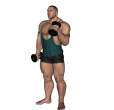 Hammer Curl - Alternate
Hammer Curl - Alternate
Benefits: The Alternative Hammer Curl places greater relative intensity on the biceps muscle.
Purpose: The Alternate Hammer Curl focuses on the biceps but also involves the brachioradialis.
Beginner Biceps Forearms Shoulders Strength Dumbbell Pull Gym
General Info: The biceps is a straight muscle with two heads. The long head of the biceps crosses both the elbow and the shoulder joints. It bends the elbow and raises the arm forward at the shoulder. The short head crosses the elbow joint and, in conjunction with the brachioradialis muscle, supinates the hand.
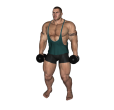 Hammer Curl - Basic
Hammer Curl - Basic
Benefits: The Hammer Curl places greater relative intensity on the biceps muscle. Using a hammer grip keeps the hands in a very strong position.
Purpose: The Hammer Curl focuses on the biceps but also involves the brachioradialis.
Beginner Biceps Forearms Shoulders Strength Dumbbell Pull Gym
General Info: The biceps is a straight muscle with two heads. The long head of the biceps crosses both the elbow and the shoulder joints. It bends the elbow and raises the arm forward at the shoulder. The short head crosses the elbow joint and, in conjunction with the brachioradialis muscle, supinates the hand.
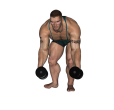 Hammer Curl - Bent Over
Hammer Curl - Bent Over
Benefits: This exercise is similar in effect to the Spider curl and does a good job of placing maximum tension on the biceps in the fully contracted position.
Purpose: This exercise works the biceps muscles but focuses also on the brachioradialis (a muscle that crosses the elbow joint and assists in rotating the forearm).
Beginner Biceps Forearms Shoulders Strength Dumbbell Pull Gym
General Info: The biceps is a straight muscle which has two heads. The long head crosses both the elbow and the shoulder joints. It bends the arm at the elbow and raises the arm forward at the shoulder. The short head crosses the elbow joint and, in conjunction with the brachioradialis, supinates the hand.
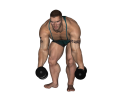 Hammer Curl - Bent Over Dumbbell Alternate
Hammer Curl - Bent Over Dumbbell Alternate
Benefits: This exercise does a good job of placing maximum tension on the biceps in the fully contracted position and also supinates the forearm..
Purpose: This exercise works the biceps muscles but focuses also on the brachioradialis (a muscle that crosses the elbow joint and assists in rotating the forearm).
Beginner Biceps Forearms Shoulders Strength Dumbbell Pull Gym
General Info: The biceps is a straight muscle which has two heads. The long head crosses both the elbow and the shoulder joints. It bends the arm at the elbow and raises the arm forward at the shoulder. The short head crosses the elbow joint and, in conjunction with the brachioradialis, supinates the hand.
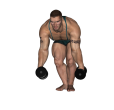 Hammer Curl - Bent Over Narrow Stance
Hammer Curl - Bent Over Narrow Stance
Benefits: This exercise does a good job of placing maximum tension on the biceps in the fully contracted position and also supinates the forearm..
Purpose: This exercise works the biceps muscles but focuses also on the brachioradialis (a muscle that crosses the elbow joint and assists in rotating the forearm).
Beginner Biceps Forearms Shoulders Strength Dumbbell Pull Gym
General Info: The biceps is a straight muscle which has two heads. The long head crosses both the elbow and the shoulder joints. It bends the arm at the elbow and raises the arm forward at the shoulder. The short head crosses the elbow joint and, in conjunction with the brachioradialis, supinates the hand.
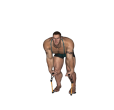 Hammer Curl - Bent Over Resistance
Hammer Curl - Bent Over Resistance
Benefits: This exercise is similar in effect to the Spider curl and does a good job of placing maximum tension on the biceps in the fully contracted position.
Purpose: This exercise works the biceps muscles but focuses also on the brachioradialis (a muscle that crosses the elbow joint and assists in rotating the forearm).
Beginner Biceps Forearms Shoulders Strength Resistance Tube Pull Gym
General Info: The biceps is a straight muscle which has two heads. The long head crosses both the elbow and the shoulder joints. It bends the arm at the elbow and raises the arm forward at the shoulder. The short head crosses the elbow joint and, in conjunction with the brachioradialis, supinates the hand.
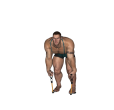 Hammer Curl - Bent Over Resistance Alternate
Hammer Curl - Bent Over Resistance Alternate
Benefits: This exercise is similar in effect to the Spider curl and does a good job of placing maximum tension on the biceps in the fully contracted position.
Purpose: This exercise works the biceps muscles but focuses also on the brachioradialis (a muscle that crosses the elbow joint and assists in rotating the forearm).
Beginner Biceps Forearms Shoulders Strength Resistance Tube Pull Gym
General Info: The biceps is a straight muscle which has two heads. The long head crosses both the elbow and the shoulder joints. It bends the arm at the elbow and raises the arm forward at the shoulder. The short head crosses the elbow joint and, in conjunction with the brachioradialis, supinates the hand.
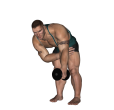 Hammer Curl - Bent Over Single
Hammer Curl - Bent Over Single
Benefits: The hammer curl places greater relative intensity on the brachioradialis muscle.
Purpose: The Alternate Hammer Curl focuses on the biceps but also involves the brachioradialis.
Beginner Biceps Forearms Shoulders Strength Dumbbell Pull Gym
General Info: The biceps is a straight muscle with two heads. The long head of the biceps crosses both the elbow and the shoulder joints. It bends the elbow and raises the arm forward at the shoulder. The short head crosses the elbow joint and, in conjunction with the brachioradialis muscle, supinates the hand.
 Hammer Curl - Bent Over Water Bottle
Hammer Curl - Bent Over Water Bottle
Benefits: This exercise is similar in effect to the Spider curl and does a good job of placing maximum tension on the biceps in the fully contracted position.
Purpose: This exercise works the biceps muscles but focuses also on the brachioradialis (a muscle that crosses the elbow joint and assists in rotating the forearm).
Beginner Biceps Forearms Shoulders Strength Water Bottle Pull Home
General Info: The biceps is a straight muscle which has two heads. The long head crosses both the elbow and the shoulder joints. It bends the arm at the elbow and raises the arm forward at the shoulder. The short head crosses the elbow joint and, in conjunction with the brachioradialis, supinates the hand.
 Hammer Curl - Bent Over Water Bottle Alternate
Hammer Curl - Bent Over Water Bottle Alternate
Benefits: This exercise does a good job of placing maximum tension on the biceps in the fully contracted position and also supinates the forearm..
Purpose: This exercise works the biceps muscles but focuses also on the brachioradialis (a muscle that crosses the elbow joint and assists in rotating the forearm).
Beginner Biceps Forearms Shoulders Strength Water Bottle Pull Home
General Info: The biceps is a straight muscle which has two heads. The long head crosses both the elbow and the shoulder joints. It bends the arm at the elbow and raises the arm forward at the shoulder. The short head crosses the elbow joint and, in conjunction with the brachioradialis, supinates the hand.
 Hammer Curl - Bent Over Water Bottle Narrow
Hammer Curl - Bent Over Water Bottle Narrow
Benefits: This exercise does a good job of placing maximum tension on the biceps in the fully contracted position and also supinates the forearm..
Purpose: This exercise works the biceps muscles but focuses also on the brachioradialis (a muscle that crosses the elbow joint and assists in rotating the forearm).
Beginner Biceps Forearms Shoulders Strength Water Bottle Pull Home
General Info: The biceps is a straight muscle which has two heads. The long head crosses both the elbow and the shoulder joints. It bends the arm at the elbow and raises the arm forward at the shoulder. The short head crosses the elbow joint and, in conjunction with the brachioradialis, supinates the hand.
 Hammer Curl - Bent Over Water Bottle Single
Hammer Curl - Bent Over Water Bottle Single
Benefits: The hammer curl places greater relative intensity on the brachioradialis muscle.
Purpose: The Alternate Hammer Curl focuses on the biceps but also involves the brachioradialis.
Beginner Biceps Forearms Shoulders Strength Water Bottle Pull Home
General Info: The biceps is a straight muscle with two heads. The long head of the biceps crosses both the elbow and the shoulder joints. It bends the elbow and raises the arm forward at the shoulder. The short head crosses the elbow joint and, in conjunction with the brachioradialis muscle, supinates the hand.
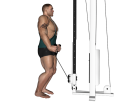 Hammer Curl - Cable Rope Attachment
Hammer Curl - Cable Rope Attachment
Benefits: The Cable Hammer Curl places greater relative intensity on the biceps muscle because there is always tension on the cable. Using a hammer grip keeps the hands in a very strong position.
Purpose: The Cable Hammer Curl focuses on the biceps but also involves the brachioradialis.
Beginner Biceps Forearms Shoulders Strength High Low Cable Machine Cable Rope Attachment Pull Gym
General Info: The biceps is a straight muscle with two heads. The long head of the biceps crosses both the elbow and the shoulder joints. It bends the elbow and raises the arm forward at the shoulder. The short head crosses the elbow joint and, in conjunction with the brachioradialis muscle, supinates the hand.
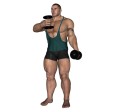 Hammer Curl - Cross Body
Hammer Curl - Cross Body
Benefits: This exercise works both heads of the biceps with a heavier weight than can typically be done with dumbbells.
Purpose: This exercise is used to target the biceps muscle to develop size, definition, strength, endurance and power.
Intermediate Biceps Forearms Shoulders Strength Dumbbell Pull Gym
General Info: The biceps is a straight muscle with two heads. The long head of the biceps crosses both the elbow and the shoulder joint. It bends the elbow and raises the arm forward at the shoulder. The short head crosses the elbow joint and, in conjunction with the brachioradialis, supinates the hand.
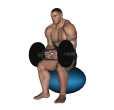 Hammer Curl - Fitness Ball Barbell
Hammer Curl - Fitness Ball Barbell
Benefits: This exercise isolates the biceps so that momentum does not come into play.
Purpose: This exercise strengthens the biceps.
Beginner Biceps Forearms Strength Hammer Barbell Fitness Ball Pull Gym
General Info: The biceps muscle is a straight muscle with 2 heads. The long head crosses both the elbow and shoulder joints and bends the elbow and raises the arm forward at the shoulder. The short head of the biceps crosses the elbow joint and, in conjunction with the brachioradialis, supinates the hand..
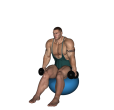 Hammer Curl - Fitness Ball Dumbbell
Hammer Curl - Fitness Ball Dumbbell
Benefits: This exercise isolates the biceps so that momentum does not come into play.
Purpose: This exercise strengthens the biceps.
Beginner Biceps Forearms Strength Dumbbell Fitness Ball Pull Gym
General Info: The biceps muscle is a straight muscle with 2 heads. The long head crosses both the elbow and shoulder joints and bends the elbow and raises the arm forward at the shoulder. The short head of the biceps crosses the elbow joint and, in conjunction with the brachioradialis, supinates the hand.
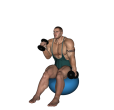 Hammer Curl - Fitness Ball Dumbbell Alternate
Hammer Curl - Fitness Ball Dumbbell Alternate
Benefits: This exercise isolates the biceps so that momentum does not come into play.
Purpose: This exercise strengthens the biceps.
Beginner Biceps Forearms Shoulders Traps Strength Dumbbell Fitness Ball Pull Gym
General Info: The biceps muscle is a straight muscle with 2 heads. The long head crosses both the elbow and shoulder joints and bends the elbow and raises the arm forward at the shoulder. The short head of the biceps crosses the elbow joint and, in conjunction with the brachioradialis, supinates the hand.
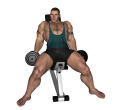 Hammer Curl - Incline Dumbbell
Hammer Curl - Incline Dumbbell
Benefits: The Hammer Curl places greater relative intensity on the biceps muscle.
Purpose: The Hammer Curl focuses on the biceps but also involves the brachioradialis.
Beginner Biceps Forearms Shoulders Strength Dumbbell Incline Bench Pull Gym
General Info: The biceps is a straight muscle with two heads. The long head of the biceps crosses both the elbow and the shoulder joints. It bends the elbow and raises the arm forward at the shoulder. The short head crosses the elbow joint and, in conjunction with the brachioradialis muscle, supinates the hand.
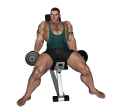 Hammer Curl - Incline Dumbbell Alternate
Hammer Curl - Incline Dumbbell Alternate
Benefits: The Alternative Hammer Curl places greater relative intensity on the biceps muscle.
Purpose: The Alternate Hammer Curl focuses on the biceps but also involves the brachioradialis.
Beginner Biceps Forearms Shoulders Strength Dumbbell Incline Bench Pull Gym
General Info: The biceps is a straight muscle with two heads. The long head of the biceps crosses both the elbow and the shoulder joints. It bends the elbow and raises the arm forward at the shoulder. The short head crosses the elbow joint and, in conjunction with the brachioradialis muscle, supinates the hand.
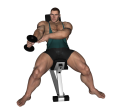 Hammer Curl - Incline Single
Hammer Curl - Incline Single
Benefits: This exercise works both heads of the biceps with a heavier weight than can typically be done with dumbbells.
Purpose: This exercise is used to target the biceps muscle to develop size, definition, strength, endurance and power.
Beginner Biceps Forearms Shoulders Strength Dumbbell Incline Bench Pull Gym
General Info: The biceps is a straight muscle with two heads. The long head of the biceps crosses both the elbow and the shoulder joint. It bends the elbow and raises the arm forward at the shoulder. The short head crosses the elbow joint and, in conjunction with the brachioradialis, supinates the hand.
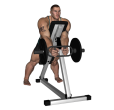 Hammer Curl - Overhang Barbell
Hammer Curl - Overhang Barbell
Benefits: This exercise is similar in effect to the Spider curl and does a good job of placing maximum tension on the biceps in the fully contracted position.
Purpose: This exercise works the biceps muscles.
Beginner Biceps Strength Hammer Barbell Incline Bench Pull Gym
General Info: The biceps muscle is a straight muscle with 2 heads. The long head crosses both the elbow and shoulder joints and bends the elbow and raises the arm forward at the shoulder. The short head of the biceps crosses the elbow joint and, in conjunction with the brachioradialis, supinates the hand.
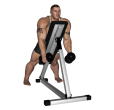 Hammer Curl - Overhang Dumbbell
Hammer Curl - Overhang Dumbbell
Benefits: This exercise is similar in effect to the Spider curl and does a good job of placing maximum tension on the biceps in the fully contracted position.
Purpose: This exercise works the biceps muscles.
Beginner Biceps Strength Dumbbell Incline Bench Pull Gym
General Info: The biceps muscle is a straight muscle with 2 heads. The long head crosses both the elbow and shoulder joints and bends the elbow and raises the arm forward at the shoulder. The short head of the biceps crosses the elbow joint and, in conjunction with the brachioradialis, supinates the hand.
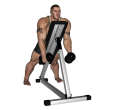 Hammer Curl - Overhang Dumbbell Alternate
Hammer Curl - Overhang Dumbbell Alternate
Benefits: This exercise is similar in effect to the Spider curl and does a good job of placing maximum tension on the biceps in the fully contracted position.
Purpose: This exercise works the biceps muscles.
Beginner Biceps Strength Dumbbell Incline Bench Pull Gym
General Info: The biceps muscle is a straight muscle with 2 heads. The long head crosses both the elbow and shoulder joints and bends the elbow and raises the arm forward at the shoulder. The short head of the biceps crosses the elbow joint and, in conjunction with the brachioradialis, supinates the hand.
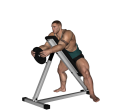 Hammer Curl - Overhang Plate
Hammer Curl - Overhang Plate
Benefits: This exercise is similar in effect to the Spider curl and does a good job of placing maximum tension on the biceps in the fully contracted position.
Purpose: This exercise works the biceps muscles.
Intermediate Biceps Strength Plate Incline Bench Pull Gym
General Info: The biceps muscle is a straight muscle with 2 heads. The long head crosses both the elbow and shoulder joints and bends the elbow and raises the arm forward at the shoulder. The short head of the biceps crosses the elbow joint and, in conjunction with the brachioradialis, supinates the hand.
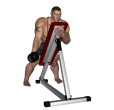 Hammer Curl - Overhang Single Dumbbell
Hammer Curl - Overhang Single Dumbbell
Benefits: This exercise is similar in effect to the Spider curl and does a good job of placing maximum tension on the biceps in the fully contracted position.
Purpose: This exercise works the biceps muscles.
Beginner Biceps Strength Dumbbell Incline Bench Pull Gym
General Info: The biceps muscle is a straight muscle with 2 heads. The long head crosses both the elbow and shoulder joints and bends the elbow and raises the arm forward at the shoulder. The short head of the biceps crosses the elbow joint and, in conjunction with the brachioradialis, supinates the hand.
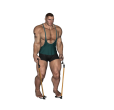 Hammer Curl - Resistance Tube
Hammer Curl - Resistance Tube
Benefits: The Alternative Hammer Curl places greater relative intensity on the biceps muscle. Using a hammer grip keeps the hands in a very strong position.
Purpose: The Alternate Hammer Curl focuses on the biceps but also involves the brachioradialis.
Beginner Biceps Forearms Shoulders Strength Resistance Tube Pull Gym
General Info: The biceps is a straight muscle with two heads. The long head of the biceps crosses both the elbow and the shoulder joints. It bends the elbow and raises the arm forward at the shoulder. The short head crosses the elbow joint and, in conjunction with the brachioradialis muscle, supinates the hand.
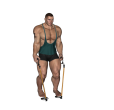 Hammer Curl - Resistance Tube Alternate
Hammer Curl - Resistance Tube Alternate
Benefits: The Alternative Hammer Curl places greater relative intensity on the biceps muscle. Using a hammer grip keeps the hands in a very strong position.
Purpose: The Alternate Hammer Curl focuses on the biceps but also involves the brachioradialis.
Beginner Biceps Forearms Shoulders Strength Resistance Tube Pull Gym
General Info: The biceps is a straight muscle with two heads. The long head of the biceps crosses both the elbow and the shoulder joints. It bends the elbow and raises the arm forward at the shoulder. The short head crosses the elbow joint and, in conjunction with the brachioradialis muscle, supinates the hand.
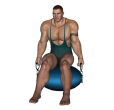 Hammer Curl - Resistance Tube Ball
Hammer Curl - Resistance Tube Ball
Benefits: This exercise isolates the biceps so that momentum does not come into play.
Purpose: This exercise strengthens the biceps.
Beginner Biceps Forearms Strength Fitness Ball Resistance Tube Pull Gym
General Info: The biceps muscle is a straight muscle with 2 heads. The long head crosses both the elbow and shoulder joints and bends the elbow and raises the arm forward at the shoulder. The short head of the biceps crosses the elbow joint and, in conjunction with the brachioradialis, supinates the hand..
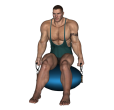 Hammer Curl - Resistance Tube Ball Alternate
Hammer Curl - Resistance Tube Ball Alternate
Benefits: This exercise isolates the biceps so that momentum does not come into play.
Purpose: This exercise strengthens the biceps.
Beginner Biceps Forearms Strength Fitness Ball Resistance Tube Pull Gym
General Info: The biceps muscle is a straight muscle with 2 heads. The long head crosses both the elbow and shoulder joints and bends the elbow and raises the arm forward at the shoulder. The short head of the biceps crosses the elbow joint and, in conjunction with the brachioradialis, supinates the hand..
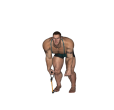 Hammer Curl - Resistance Tube Bent Single
Hammer Curl - Resistance Tube Bent Single
Benefits: This exercise isolates the biceps so that momentum does not come into play.
Purpose: This exercise strengthens the biceps.
Beginner Biceps Forearms Strength Resistance Tube Pull Gym
General Info: The biceps muscle is a straight muscle with 2 heads. The long head crosses both the elbow and shoulder joints and bends the elbow and raises the arm forward at the shoulder. The short head of the biceps crosses the elbow joint and, in conjunction with the brachioradialis, supinates the hand..
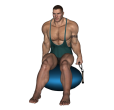 Hammer Curl - Resistance Tube Seated Single
Hammer Curl - Resistance Tube Seated Single
Benefits: This exercise isolates the biceps so that momentum does not come into play.
Purpose: This exercise strengthens the biceps.
Beginner Biceps Forearms Shoulders Traps Strength Resistance Tube Fitness Ball Pull Gym
General Info: The biceps muscle is a straight muscle with 2 heads. The long head crosses both the elbow and shoulder joints and bends the elbow and raises the arm forward at the shoulder. The short head of the biceps crosses the elbow joint and, in conjunction with the brachioradialis, supinates the hand.
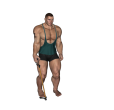 Hammer Curl - Resistance Tube Single
Hammer Curl - Resistance Tube Single
Benefits: This exercise works both heads of the biceps with a heavier weight than can typically be done with dumbbells.
Purpose: This exercise is used to target the biceps muscle to develop size, definition, strength, endurance and power.
Beginner Biceps Forearms Shoulders Strength Resistance Tube Pull Gym
General Info: The biceps is a straight muscle with two heads. The long head of the biceps crosses both the elbow and the shoulder joint. It bends the elbow and raises the arm forward at the shoulder. The short head crosses the elbow joint and, in conjunction with the brachioradialis, supinates the hand.
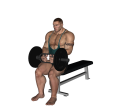 Hammer Curl - Seated Barbell
Hammer Curl - Seated Barbell
Benefits: This exercise isolates the biceps so that momentum does not come into play. Using a hammer grip keeps the hands in a very strong position.
Purpose: This exercise strengthens the biceps.
Beginner Biceps Forearms Shoulders Traps Strength Hammer Barbell Flat Bench Pull Gym
General Info: The biceps muscle is a straight muscle with 2 heads. The long head crosses both the elbow and shoulder joints and bends the elbow and raises the arm forward at the shoulder. The short head of the biceps crosses the elbow joint and, in conjunction with the brachioradialis, supinates the hand..
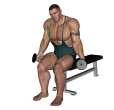 Hammer Curl - Seated Dumbbell
Hammer Curl - Seated Dumbbell
Benefits: This exercise isolates the biceps so that momentum does not come into play. Using a hammer grip keeps the hands in a very strong position.
Purpose: This exercise strengthens the biceps.
Beginner Biceps Forearms Shoulders Traps Strength Dumbbell Flat Bench Pull Gym
General Info: The biceps muscle is a straight muscle with 2 heads. The long head crosses both the elbow and shoulder joints and bends the elbow and raises the arm forward at the shoulder. The short head of the biceps crosses the elbow joint and, in conjunction with the brachioradialis, supinates the hand..
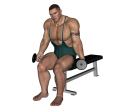 Hammer Curl - Seated Dumbbell Alternate
Hammer Curl - Seated Dumbbell Alternate
Benefits: This exercise isolates the biceps so that momentum does not come into play. Using a hammer grip keeps the hands in a very strong position.
Purpose: This exercise strengthens the biceps.
Beginner Biceps Forearms Shoulders Traps Strength Dumbbell Flat Bench Pull Gym
General Info: The biceps muscle is a straight muscle with 2 heads. The long head crosses both the elbow and shoulder joints and bends the elbow and raises the arm forward at the shoulder. The short head of the biceps crosses the elbow joint and, in conjunction with the brachioradialis, supinates the hand..
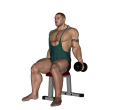 Hammer Curl - Seated Dumbbell Feet Up
Hammer Curl - Seated Dumbbell Feet Up
Benefits: This exercise isolates the biceps so that momentum does not come into play.
Purpose: This exercise strengthens the biceps.
Intermediate Biceps Forearms Shoulders Traps Strength Dumbbell Flat Bench Pull Gym
General Info: The biceps muscle is a straight muscle with 2 heads. The long head crosses both the elbow and shoulder joints and bends the elbow and raises the arm forward at the shoulder. The short head of the biceps crosses the elbow joint and, in conjunction with the brachioradialis, supinates the hand..
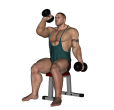 Hammer Curl - Seated Dumbbell Feet Up Alternate
Hammer Curl - Seated Dumbbell Feet Up Alternate
Benefits: This exercise isolates the biceps so that momentum does not come into play.
Purpose: This exercise strengthens the biceps.
Intermediate Biceps Forearms Shoulders Traps Strength Dumbbell Flat Bench Pull Gym
General Info: The biceps muscle is a straight muscle with 2 heads. The long head crosses both the elbow and shoulder joints and bends the elbow and raises the arm forward at the shoulder. The short head of the biceps crosses the elbow joint and, in conjunction with the brachioradialis, supinates the hand..
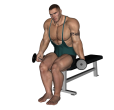 Hammer Curl - Seated Dumbbell Narrow
Hammer Curl - Seated Dumbbell Narrow
Benefits: This exercise isolates the biceps so that momentum does not come into play.
Purpose: This exercise strengthens the biceps.
Beginner Biceps Forearms Shoulders Traps Strength Dumbbell Flat Bench Pull Gym
General Info: The biceps muscle is a straight muscle with 2 heads. The long head crosses both the elbow and shoulder joints and bends the elbow and raises the arm forward at the shoulder. The short head of the biceps crosses the elbow joint and, in conjunction with the brachioradialis, supinates the hand..
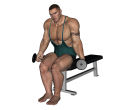 Hammer Curl - Seated Dumbbell Narrow Alternate
Hammer Curl - Seated Dumbbell Narrow Alternate
Benefits: This exercise isolates the biceps so that momentum does not come into play.
Purpose: This exercise strengthens the biceps.
Beginner Biceps Forearms Shoulders Traps Strength Dumbbell Flat Bench Pull Gym
General Info: The biceps muscle is a straight muscle with 2 heads. The long head crosses both the elbow and shoulder joints and bends the elbow and raises the arm forward at the shoulder. The short head of the biceps crosses the elbow joint and, in conjunction with the brachioradialis, supinates the hand..
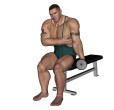 Hammer Curl - Seated Dumbbell Single
Hammer Curl - Seated Dumbbell Single
Benefits: This exercise isolates the biceps so that momentum does not come into play.
Purpose: This exercise strengthens the biceps.
Beginner Biceps Forearms Shoulders Traps Strength Dumbbell Flat Bench Pull Gym
General Info: The biceps muscle is a straight muscle with 2 heads. The long head crosses both the elbow and shoulder joints and bends the elbow and raises the arm forward at the shoulder. The short head of the biceps crosses the elbow joint and, in conjunction with the brachioradialis, supinates the hand..
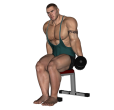 Hammer Curl - Seated Dumbbell Single Narrow
Hammer Curl - Seated Dumbbell Single Narrow
Benefits: This exercise isolates the biceps so that momentum does not come into play.
Purpose: This exercise strengthens the biceps.
Beginner Biceps Forearms Shoulders Traps Strength Dumbbell Flat Bench Pull Gym
General Info: The biceps muscle is a straight muscle with 2 heads. The long head crosses both the elbow and shoulder joints and bends the elbow and raises the arm forward at the shoulder. The short head of the biceps crosses the elbow joint and, in conjunction with the brachioradialis, supinates the hand..
 Hammer Curl - Seated Water Bottle
Hammer Curl - Seated Water Bottle
Benefits: This exercise isolates the biceps so that momentum does not come into play.
Purpose: This exercise strengthens the biceps.
Beginner Biceps Forearms Shoulders Traps Strength Water Bottle Chair Pull Home
General Info: The biceps muscle is a straight muscle with 2 heads. The long head crosses both the elbow and shoulder joints and bends the elbow and raises the arm forward at the shoulder. The short head of the biceps crosses the elbow joint and, in conjunction with the brachioradialis, supinates the hand..
 Hammer Curl - Seated Water Bottle Alternate
Hammer Curl - Seated Water Bottle Alternate
Benefits: This exercise isolates the biceps so that momentum does not come into play.
Purpose: This exercise strengthens the biceps.
Beginner Biceps Forearms Shoulders Traps Strength Water Bottle Chair Pull Home
General Info: The biceps muscle is a straight muscle with 2 heads. The long head crosses both the elbow and shoulder joints and bends the elbow and raises the arm forward at the shoulder. The short head of the biceps crosses the elbow joint and, in conjunction with the brachioradialis, supinates the hand..
 Hammer Curl - Seated Water Bottle Feet Up
Hammer Curl - Seated Water Bottle Feet Up
Benefits: This exercise isolates the biceps so that momentum does not come into play.
Purpose: This exercise strengthens the biceps.
Intermediate Biceps Forearms Shoulders Traps Strength Water Bottle Chair Pull Home
General Info: The biceps muscle is a straight muscle with 2 heads. The long head crosses both the elbow and shoulder joints and bends the elbow and raises the arm forward at the shoulder. The short head of the biceps crosses the elbow joint and, in conjunction with the brachioradialis, supinates the hand..
 Hammer Curl - Seated Water Bottle Feet Up Alternate
Hammer Curl - Seated Water Bottle Feet Up Alternate
Benefits: This exercise isolates the biceps so that momentum does not come into play.
Purpose: This exercise strengthens the biceps.
Intermediate Biceps Forearms Shoulders Traps Strength Water Bottle Chair Pull Home
General Info: The biceps muscle is a straight muscle with 2 heads. The long head crosses both the elbow and shoulder joints and bends the elbow and raises the arm forward at the shoulder. The short head of the biceps crosses the elbow joint and, in conjunction with the brachioradialis, supinates the hand..
 Hammer Curl - Seated Water Bottle Narrow
Hammer Curl - Seated Water Bottle Narrow
Benefits: This exercise isolates the biceps so that momentum does not come into play.
Purpose: This exercise strengthens the biceps.
Beginner Biceps Forearms Shoulders Traps Strength Water Bottle Chair Pull Home
General Info: The biceps muscle is a straight muscle with 2 heads. The long head crosses both the elbow and shoulder joints and bends the elbow and raises the arm forward at the shoulder. The short head of the biceps crosses the elbow joint and, in conjunction with the brachioradialis, supinates the hand..
 Hammer Curl - Seated Water Bottle Narrow Alternate
Hammer Curl - Seated Water Bottle Narrow Alternate
Benefits: This exercise isolates the biceps so that momentum does not come into play.
Purpose: This exercise strengthens the biceps.
Beginner Biceps Forearms Shoulders Traps Strength Water Bottle Chair Pull Home
General Info: The biceps muscle is a straight muscle with 2 heads. The long head crosses both the elbow and shoulder joints and bends the elbow and raises the arm forward at the shoulder. The short head of the biceps crosses the elbow joint and, in conjunction with the brachioradialis, supinates the hand..
 Hammer Curl - Seated Water Bottle Single
Hammer Curl - Seated Water Bottle Single
Benefits: This exercise isolates the biceps so that momentum does not come into play.
Purpose: This exercise strengthens the biceps.
Beginner Biceps Forearms Shoulders Traps Strength Water Bottle Chair Pull Home
General Info: The biceps muscle is a straight muscle with 2 heads. The long head crosses both the elbow and shoulder joints and bends the elbow and raises the arm forward at the shoulder. The short head of the biceps crosses the elbow joint and, in conjunction with the brachioradialis, supinates the hand..
 Hammer Curl - Seated Water Bottle Single Narrow
Hammer Curl - Seated Water Bottle Single Narrow
Benefits: This exercise isolates the biceps so that momentum does not come into play.
Purpose: This exercise strengthens the biceps.
Beginner Biceps Forearms Shoulders Traps Strength Water Bottle Chair Pull Home
General Info: The biceps muscle is a straight muscle with 2 heads. The long head crosses both the elbow and shoulder joints and bends the elbow and raises the arm forward at the shoulder. The short head of the biceps crosses the elbow joint and, in conjunction with the brachioradialis, supinates the hand..
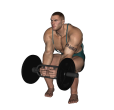 Hammer Curl - Squat Barbell
Hammer Curl - Squat Barbell
Benefits: This exercise isolates the biceps so that momentum does not come into play.
Purpose: This exercise strengthens the biceps.
Intermediate Biceps Forearms Shoulders Traps Strength Hammer Barbell Pull Gym
General Info: The biceps muscle is a straight muscle with 2 heads. The long head crosses both the elbow and shoulder joints and bends the elbow and raises the arm forward at the shoulder. The short head of the biceps crosses the elbow joint and, in conjunction with the brachioradialis, supinates the hand..
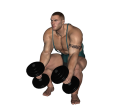 Hammer Curl - Squat Dumbbell
Hammer Curl - Squat Dumbbell
Benefits: This exercise isolates the biceps so that momentum does not come into play.
Purpose: This exercise strengthens the biceps.
Beginner Biceps Forearms Shoulders Traps Strength Dumbbell Pull Gym
General Info: The biceps muscle is a straight muscle with 2 heads. The long head crosses both the elbow and shoulder joints and bends the elbow and raises the arm forward at the shoulder. The short head of the biceps crosses the elbow joint and, in conjunction with the brachioradialis, supinates the hand..
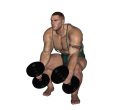 Hammer Curl - Squat Dumbbell Single
Hammer Curl - Squat Dumbbell Single
Benefits: This exercise isolates the biceps so that momentum does not come into play.
Purpose: This exercise strengthens the biceps.
Beginner Biceps Forearms Shoulders Traps Strength Dumbbell Pull Gym
General Info: The biceps muscle is a straight muscle with 2 heads. The long head crosses both the elbow and shoulder joints and bends the elbow and raises the arm forward at the shoulder. The short head of the biceps crosses the elbow joint and, in conjunction with the brachioradialis, supinates the hand..
 Hammer Curl - Squat Water Bottle
Hammer Curl - Squat Water Bottle
Benefits: This exercise isolates the biceps so that momentum does not come into play.
Purpose: This exercise strengthens the biceps.
Beginner Biceps Forearms Shoulders Traps Strength Water Bottle Pull Home
General Info: The biceps muscle is a straight muscle with 2 heads. The long head crosses both the elbow and shoulder joints and bends the elbow and raises the arm forward at the shoulder. The short head of the biceps crosses the elbow joint and, in conjunction with the brachioradialis, supinates the hand..
 Hammer Curl - Squat Water Bottle Single
Hammer Curl - Squat Water Bottle Single
Benefits: This exercise isolates the biceps so that momentum does not come into play.
Purpose: This exercise strengthens the biceps.
Beginner Biceps Forearms Shoulders Traps Strength Water Bottle Pull Home
General Info: The biceps muscle is a straight muscle with 2 heads. The long head crosses both the elbow and shoulder joints and bends the elbow and raises the arm forward at the shoulder. The short head of the biceps crosses the elbow joint and, in conjunction with the brachioradialis, supinates the hand..
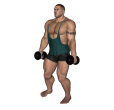 Hammer Curl - Standing
Hammer Curl - Standing
Benefits: This exercise works both heads of the biceps with a heavier weight than can typically be done with dumbbells.
Purpose: This exercise is used to target the biceps. Using a hammer grip keeps the hands in a very strong position.
Beginner Biceps Forearms Shoulders Strength Dumbbell Pull Gym
General Info: The biceps is a straight muscle with two heads. The long head of the biceps crosses both the elbow and the shoulder joint. It bends the elbow and raises the arm forward at the shoulder. The short head crosses the elbow joint and, in conjunction with the brachioradialis, supinates the hand.
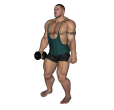 Hammer Curl - Standing Dumbbell Single
Hammer Curl - Standing Dumbbell Single
Benefits: This exercise isolates the biceps so that momentum does not come into play. Using a hammer grip keeps the hands in a very strong position.
Purpose: This exercise strengthens the biceps.
Beginner Biceps Forearms Shoulders Traps Strength Dumbbell Pull Gym
General Info: The biceps muscle is a straight muscle with 2 heads. The long head crosses both the elbow and shoulder joints and bends the elbow and raises the arm forward at the shoulder. The short head of the biceps crosses the elbow joint and, in conjunction with the brachioradialis, supinates the hand..
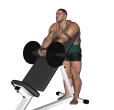 Hammer Curl - Standing Incline Barbell
Hammer Curl - Standing Incline Barbell
Benefits: This exercise works both heads of the biceps similar to a hammer barbell preacher curl.
Purpose: This exercise is used to target the biceps muscle to develop size, definition, strength, endurance and power.
Beginner Biceps Forearms Shoulders Strength Hammer Barbell Incline Bench Pull Gym
General Info: The biceps is a straight muscle with two heads. The long head of the biceps crosses both the elbow and the shoulder joint. It bends the elbow and raises the arm forward at the shoulder. The short head crosses the elbow joint and, in conjunction with the brachioradialis, supinates the hand.
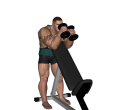 Hammer Curl - Standing Incline Dumbbell
Hammer Curl - Standing Incline Dumbbell
Benefits: This exercise works both heads of the biceps similar to a hammer dumbbell preacher curl.
Purpose: This exercise is used to target the biceps muscle to develop size, definition, strength, endurance and power.
Beginner Biceps Forearms Shoulders Strength Dumbbell Incline Bench Pull Gym
General Info: The biceps is a straight muscle with two heads. The long head of the biceps crosses both the elbow and the shoulder joint. It bends the elbow and raises the arm forward at the shoulder. The short head crosses the elbow joint and, in conjunction with the brachioradialis, supinates the hand.
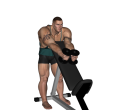 Hammer Curl - Standing Incline Dumbbell Alternate
Hammer Curl - Standing Incline Dumbbell Alternate
Benefits: This exercise works both heads of the biceps with a heavier weight than can typically be done with dumbbells.
Purpose: This exercise is used to target the biceps muscle to develop size, definition, strength, endurance and power.
Beginner Biceps Forearms Shoulders Strength Dumbbell Incline Bench Pull Gym
General Info: The biceps is a straight muscle with two heads. The long head of the biceps crosses both the elbow and the shoulder joint. It bends the elbow and raises the arm forward at the shoulder. The short head crosses the elbow joint and, in conjunction with the brachioradialis, supinates the hand.
 Hammer Curl - Standing Water Bottle
Hammer Curl - Standing Water Bottle
Benefits: This exercise works both heads of the biceps with a heavier weight than can typically be done with dumbbells.
Purpose: This exercise is used to target the biceps muscle to develop size, definition, strength, endurance and power.
Beginner Biceps Forearms Shoulders Strength Water Bottle Pull Home
General Info: The biceps is a straight muscle with two heads. The long head of the biceps crosses both the elbow and the shoulder joint. It bends the elbow and raises the arm forward at the shoulder. The short head crosses the elbow joint and, in conjunction with the brachioradialis, supinates the hand.
 Hammer Curl - Standing Water Bottle Single
Hammer Curl - Standing Water Bottle Single
Benefits: This exercise isolates the biceps so that momentum does not come into play.
Purpose: This exercise strengthens the biceps.
Beginner Biceps Forearms Shoulders Traps Strength Water Bottle Pull Home
General Info: The biceps muscle is a straight muscle with 2 heads. The long head crosses both the elbow and shoulder joints and bends the elbow and raises the arm forward at the shoulder. The short head of the biceps crosses the elbow joint and, in conjunction with the brachioradialis, supinates the hand..
 Hammer Curl - Water Bottle Alternate
Hammer Curl - Water Bottle Alternate
Benefits: The Alternative Hammer Curl places greater relative intensity on the biceps muscle.
Purpose: The Alternate Hammer Curl focuses on the biceps but also involves the brachioradialis.
Beginner Biceps Forearms Shoulders Strength Water Bottle Pull Home
General Info: The biceps is a straight muscle with two heads. The long head of the biceps crosses both the elbow and the shoulder joints. It bends the elbow and raises the arm forward at the shoulder. The short head crosses the elbow joint and, in conjunction with the brachioradialis muscle, supinates the hand.
 Hammer Curl - Water Bottle Basic
Hammer Curl - Water Bottle Basic
Benefits: The Hammer Curl places greater relative intensity on the biceps muscle.
Purpose: The Hammer Curl focuses on the biceps but also involves the brachioradialis.
Beginner Biceps Forearms Shoulders Strength Water Bottle Pull Home
General Info: The biceps is a straight muscle with two heads. The long head of the biceps crosses both the elbow and the shoulder joints. It bends the elbow and raises the arm forward at the shoulder. The short head crosses the elbow joint and, in conjunction with the brachioradialis muscle, supinates the hand.
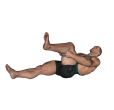 Hamstring Stretch - 90-90
Hamstring Stretch - 90-90
Benefits: A major problem with many athletes who use their legs (such as runners, footballers, ice skaters) is the hamstring injury. This exercise is a core stretch for the hamstrings which will help reduce this type of injury.
Purpose: This exercise provides flexibility and mobility of the hamstrings.
Beginner Hamstrings Calves Strength Body Only Gym Home
General Info: The Hamstring muscles group are responsible for bending the knee. Some members of this group also straighten the hip (hip extensors). They are located on the back of the thigh.
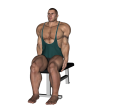 Hamstring Stretch - Chair Leg Extended
Hamstring Stretch - Chair Leg Extended
Benefits: A major problem with many athletes who use their legs (such as runners, footballers, ice skaters) is the hamstring injury. This exercise is a core stretch for the hamstrings which will help reduce this type of injury.
Purpose: This exercise provides flexibility and mobility of the hamstrings.
Beginner Hamstrings Hip Extensors Stretching Chair Gym Home
General Info: The Hamstring muscles group are responsible for bending the knee. Some members of this group also straighten the hip (hip extensors). They are located on the back of the thigh.
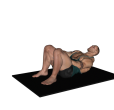 Hamstring Stretch - Leg Up
Hamstring Stretch - Leg Up
Benefits: A major problem with many athletes who use their legs (such as runners, footballers, ice skaters) is the hamstring injury. This exercise is a core stretch for the hamstrings which will help reduce this type of injury.
Purpose: This exercise provides flexibility and mobility of the hamstrings.
Beginner Hamstrings Hip Extensors Strength Body Only Gym Home
General Info: The Hamstring muscles group are responsible for bending the knee. Some members of this group also straighten the hip (hip extensors). They are located on the back of the thigh.
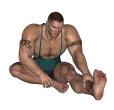 Hamstring Stretch - Seated Floor
Hamstring Stretch - Seated Floor
Benefits: A major problem with many athletes who use their legs (such as runners, footballers, ice skaters) is the hamstring injury. This exercise is a core stretch for the hamstrings which will help reduce this type of injury. The more that you can lean over (i.e., touching your chest to your knee) the more stretch you will get in your hamstrings.
Purpose: This exercise provides flexibility and mobility of the hamstrings.
Beginner Hamstrings Calves Strength Body Only Gym Home
General Info: The Hamstring muscles group are responsible for bending the knee. Some members of this group also straighten the hip (hip extensors). They are located on the back of the thigh.
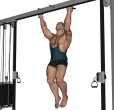 Hang - Knee To Chin
Hang - Knee To Chin
Benefits: This exercise is a great way to fine tune your abdominals.
Purpose: This exercise works the abdominals.
Beginner Abdominals Strength Chinning Bar Pull Gym
General Info: The abdominals consist of the abs and the obliques. The abs can be divided into upper abs and lower abs. The upper abs are involved in work done with the lower abs and with twisting movements (obliques).
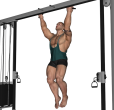 Hang - Knee To Head
Hang - Knee To Head
Benefits: This exercise is a great way to fine tune your abdominals.
Purpose: This exercise works the abdominals.
Beginner Abdominals Strength Chinning Bar Pull Gym
General Info: The abdominals consist of the abs and the obliques. The abs can be divided into upper abs and lower abs. The upper abs are involved in work done with the lower abs and with twisting movements (obliques).
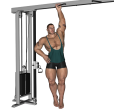 Hang - One Handed
Hang - One Handed
Benefits: This exercise is a strong, effective lats stretching exercise.
Purpose: This is a good exercise for increasing flexibility in the upper back. It also involves the biceps.
Beginner Lats Biceps Strength Chinning Bar Gym Home
General Info: There are a number of muscles in the back, although the two major muscles are the lats and traps. The lats pulls the arm back and down towards the spine. The traps pull the shoulder blades back and towards the spine.
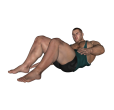 Heel Touchers - Alternate
Heel Touchers - Alternate
Benefits: Crunch exercises will give you a well-defined mid-section.
Purpose: Crunch exercises strengthen the upper abdominal muscles.
Beginner Abdominals Strength Body Only Gym Home
General Info: The abs can be divided into the abdominals themselves and the obliques. The obliques are the outer abs and are used in twisting movements. For the sake of exercising, the abdominals are sometimes divided into upper abs and lower abs (this is not a technical division but something for exercising). Both upper and lower abs are used in straight line ab exercises while the upper abs are also involved in twisting movements.
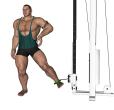 Hip Adduction - Cable
Hip Adduction - Cable
Benefits: This is a good exercise for reducing groin injuries from sports.
Purpose: This exercise is a controlled, balanced inner hip exercise for adducting the hip.
Intermediate Hip Adductors Quads Strength High Low Cable Machine Pull Gym
General Info: There are four groups of muscles that cause movement in the hip joint. They include the gluteal group, the lateral rotator group, the adductor group, and the iliopsoas group. The prime group for hip adduction is, obviously, the adductor group, a group of muscles on the inner hip joint.
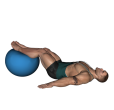 Hip Extensions - Fitness Ball
Hip Extensions - Fitness Ball
Benefits: This is a good exercise for core glute muscle development and the hip extensors.
Purpose: This exercise is a controlled, balanced glute and hip extension exercise for building tone and shape.
Beginner Glutes Hip Extensors Stretching Fitness Ball Gym
General Info: The glutes consist of the gluteus maximus, gluteus medius, and gluteus minimus. They create hip joint motion to lift the thigh forward, lift the thigh to the side, rotate the leg inward, and rotate the thigh outward.
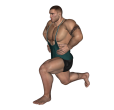 Hip Flexor - Kneeling
Hip Flexor - Kneeling
Benefits: This exercise improves the flexibility and mobility of the quads, with focus on the rectus femoris.
Purpose: This exercise stretches your quads.
Beginner Quads Hip Flexors Stretching Body Only Gym Home
General Info: The quads is a muscle group that is composed of four separate straight muscles that all act to extend the knee. One of these muscles (rectus femoris) also helps to bend the hip.
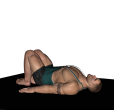 Hip Raise - Bent Knee
Hip Raise - Bent Knee
Benefits: This is a good exercise for core abdominal muscle development.
Purpose: This exercise is a controlled, balanced abs exercise for building tone and shape to the lower abs.
Beginner Abdominals Strength Body Only Compound Gym Home
General Info: The abdominal muscles have different important functions. They provide movement and support to the torso and assist in the breathing process. In addition, these muscles serve as protection for the inner organs and, together with the back muscles, provide postural support
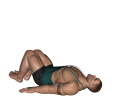 Hip Raise - Bent Knee Leg
Hip Raise - Bent Knee Leg
Benefits: This is a good exercise for core abdominal muscle development.
Purpose: This exercise is a controlled, balanced abs exercise for building tone and shape to the lower abs.
Beginner Abdominals Strength Body Only Compound Gym Home
General Info: The abdominal muscles have different important functions. They provide movement and support to the torso and assist in the breathing process. In addition, these muscles serve as protection for the inner organs and, together with the back muscles, provide postural support
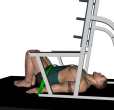 Hip Raise - With Band
Hip Raise - With Band
Benefits: This is a good exercise for core abdominal muscle development.
Purpose: This exercise is a controlled, balanced abs exercise for building tone and shape to the lower abs.
Beginner Abdominals Strength Band Power Rack Compound Gym
General Info: The abdominal muscles have different important functions. They provide movement and support to the torso and assist in the breathing process. In addition, these muscles serve as protection for the inner organs and, together with the back muscles, provide postural support
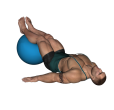 Hip Roll - Oblique Fitness Ball Alternate
Hip Roll - Oblique Fitness Ball Alternate
Benefits: Oblique crunch exercises will give you a well-defined mid-section.
Purpose: Oblique crunch exercises strengthen the side abdominal muscles.
Beginner Obliques Abdominals Strength Fitness Ball Gym Home
General Info: The abs can be divided into the abdominals themselves and the obliques. The obliques are the outer abs and are used in twisting movements. For the sake of exercising, the abdominals are sometimes divided into upper abs and lower abs (this is not a technical division but something for exercising). Both upper and lower abs are used in straight line ab exercises while the upper abs are also involved in twisting movements.
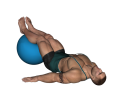 Hip Roll - Oblique Fitness Ball Single
Hip Roll - Oblique Fitness Ball Single
Benefits: Oblique crunch exercises will give you a well-defined mid-section.
Purpose: Oblique crunch exercises strengthen the side abdominal muscles.
Beginner Obliques Abdominals Strength Fitness Ball Gym Home
General Info: The abs can be divided into the abdominals themselves and the obliques. The obliques are the outer abs and are used in twisting movements. For the sake of exercising, the abdominals are sometimes divided into upper abs and lower abs (this is not a technical division but something for exercising). Both upper and lower abs are used in straight line ab exercises while the upper abs are also involved in twisting movements.
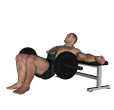 Hip Thrust - Barbell
Hip Thrust - Barbell
Benefits: This is a good exercise for core glute muscle development.
Purpose: This exercise is a controlled, balanced glute exercise for building tone and shape.
Intermediate Glutes Hamstrings Stretching Barbell Flat Bench Push Gym
General Info: The glutes consist of the gluteus maximus, gluteus medius, and gluteus minimus. They create hip joint motion to lift the thigh forward, lift the thigh to the side, rotate the leg inward, and rotate the thigh outward.
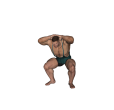 Hop - Frog
Hop - Frog
Benefits: It is the single best exercise to develop full body strength and increase your fat-burning metabolism.
Purpose: To develop core strength of the lower and middle body.
Intermediate Quads Hamstrings Strength Body Only Push Compound Gym Home
General Info: The quads are a set of four muscles in the upper front thigh. All four muscles work to straighten the knee. One of the four (rectus femoris) also helps to bend the hip. Squats are considered a vital exercise for increasing the strength and size of the legs and butt.
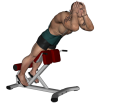 Hyperextension - Back Extensions
Hyperextension - Back Extensions
Benefits: This exercise has a different resistance curve from good mornings so these two exercises make a good combination.
Purpose: This exercise can be a powerful tool for developing the spinal erectors.
Intermediate Lower Back Hamstrings Glutes Strength Hyperextension Machine Pull Gym
General Info: The muscles of the lower back straighten the spine. They work together with the abdominals to keep the spine upright. The lower back consists of straight muscles.
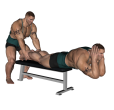 Hyperextension - No Hyperextension Bench
Hyperextension - No Hyperextension Bench
Benefits: This exercise has a different resistance curve from good mornings so these two exercises make a good combination.
Purpose: This exercise can be a powerful tool for developing the spinal erectors.
Intermediate Lower Back Hamstrings Glutes Strength Flat Bench Pull Gym
General Info: The muscles of the lower back straighten the spine. They work together with the abdominals to keep the spine upright. Good Mornings places a lot of stress on the lower back.
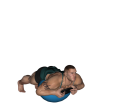 Hyperextension - Weighted Ball
Hyperextension - Weighted Ball
Benefits: This exercise has a different resistance curve from good mornings so these two exercises make a good combination.
Purpose: This exercise can be a powerful tool for developing the spinal erectors.
Intermediate Lower Back Hamstrings Glutes Strength Fitness Ball Plate Pull Gym
General Info: The muscles of the lower back straighten the spine. They work together with the abdominals to keep the spine upright. Good Mornings places a lot of stress on the lower back.
Could not find your favorite exercise in the list? Please start a discussion and post the name and the list of steps. We will try to add it as soon as we can.